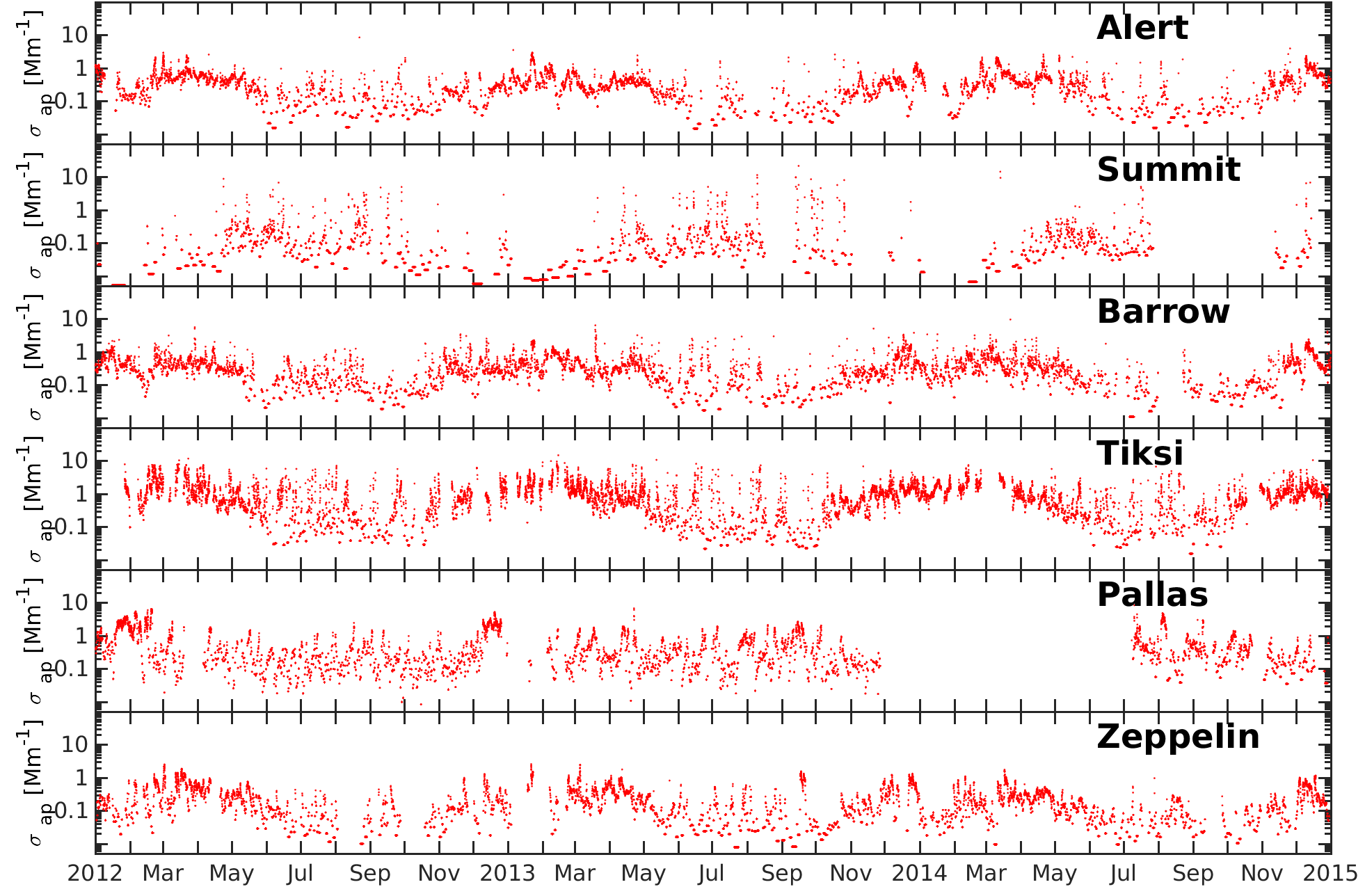Time series of aerosol light-absorption coefficients from Aethalometers at six Arctic stations between
2012 and 2014

By John Backman*, Lauren Schmeisser, Aki Virkkula, John A. Ogren, Eija Asmi, Sandra Starkweather,
Sangeeta Sharma, Konstantinos Eleftheriadis, Stergios Vratolis, Taneil Uttal, Peter Tunved, Anne
Jefferson, Michael Bergin, Alexander Makshtas, and Markus Fiebig
*Correspondence to john.backman_at_fmi.fi
DATA POLICY
The data are available free of charge for non-commercial and scientific use. By using this data,
you as data user accept that an offer of co-authorship will be made through personal contact with
the data providers or owners whenever substantial use is made of their data. In all cases, an
acknowledgement must be made to the data providers or owners and to the project name when these
data are used within a publication. When used, the dataset should be cited using the Digital Object
Identifier (DOI).
DATA FILES AND SITE SPECIFIC CONTACTS
The files names are separated according to the stations where
ALT = Alert, Canada, Sangeeta Sharma (sangeeta.sharma_at_canada.ca)
BRW = Barrow, Alaska, USA, Patrick Sheridan (Patrick.Sheridan_at_noaa.gov)
PAL = Pallas, Finland, John Backman (john.backman_at_fmi.fi)
TIK = Tiksi, Russia, Taneil Uttal (Taneil.Uttal_at_noaa.gov), John Backman (john.backman_at_fmi.fi)
SUM = Summit, Greenland, Denmark, Mike Bergin (michael.bergin_at_duke.edu), Patrick Sheridan (Patrick.Sheridan_at_noaa.gov)
ZEP = Zeppelin, Svalbard, Norway, Krejci (Radovan.Krejci_at_aces.su.se), Konstantinos Eleftheriadis (elefther_at_ipta.demokritos.gr)
INLETS AND CONDITIONING
ALT: Aethalometer is connected to a hooded total aerosol inlet. The other instruments are connected
to a PM10 inlet. The inlets are heated if needed to keep RH
BRW: All instruments are connected to a PM10 inlet. The inlet is heated, if needed, to keep RH
PAL: Aethalometer connected to a hooded total aerosol inlet whereas the MAAP and Nephelometer
are connected to a PM2.5 inlet. The total aerosol inlets is headted if needed to avoid
freezing and keep RH
TIK: All instruments connected to a PM10 inlet. The inlet is heated and the RH is generally below 30%.
SUM: All instruments connected to a PM2.5 inlet. The inlet is heated, if needed, to keep RH
ZEP: All instruments are connected to a inlet with no size cut. Sample air is heated to room
temperature before reaching the instruments which typically keeps RH below 20%.
All data are converted to standard temperature (273 K) and pressure (1013 hPa).
File naming convention and data content:
_atten_ = Light absorption coefficients b_ap(wl)nm [Mm-1] from Aethalometer data. Light absorption
coefficients b_ap(wl)nm are obtained by dividing the light attenuation coefficients b_atn(wl)nm
by 3.45 e.g. b_ap520nm = b_atn520nm/3.45 [Mm⁻¹]. This is applied to the data in the file.
_abs_ = Light absorption coefficients (b_ap(wl)nm [Mm-1]) obtained by the co-located light absorption
photometers (PSAP, CLAP, or MAAP).
_sca_ = Light scattering coefficients (b_sp(wl)nm [Mm-1]) measured by a TSI Inc. 3563 Nephelometer.
_variable_ = Timebase is varied according to the amount of attenuation coefficients as measured
by the respective Aethalometer.
_onehour_ = Timebase is one hour for the data above. For aethalometer data, same values occur when
concentration is low due to post processing as explained in the article related to this
dataset.
wl = wavelength of light
For more information about the data processing, inlets, and instrumentation visit
https://www.atmos-meas-tech-discuss.net/amt-2016-294/ which will redirect you to the revised
verson of the article.
ACKNOWLEDGEMENTS
Data used in this article are archived and accessible from the EBAS database operated at the
Norwegian Institute for Air Research (NILU) (http://ebas.nilu.no). Data management is provided
by the WMO Global Atmosphere Watch World Data Centre for Aerosol. This project has received
funding from the European Union’s Horizon 2020 research and innovation programme under grant
agreement No 654109 (ACTRIS). ALERT: Dr. Fred Hopper and technicians, and Canadian Department
of National Defence. BARROW: NOAA Oceanic and Atmospheric Research SUMMIT: NOAA Oceanic and
Atmospheric Research, National Science Foundation (OPP 1546002). TIKSI: Sara Morris and the
NOAA Oceanic and Atmospheric Research, Academy of Finland project Greenhouse gas, aerosol and
albedo variations in the changing Arctic (project number 269095) PALLAS: Academy of Finland
project Greenhouse gas, aerosol and albedo variations in the changing Arctic (project number
269095), Academy of Finland project Novel Assessment of Black Carbon in the Eurasian Arctic:
From Historical Concentrations and Sources to Future Climate Impacts (NABCEA), project number
296302 and the Academy of Finland Centre of Excellence program (project number 307331).
ZEPPELIN: Swedish Environmental Protection Agency (Naturvårdsverket), Vetenskaprådet, FORMAS,
and NILU - Norsk institutt for luftforskning.
CITATION
John Backman, Lauren Schmeisser, Aki Virkkula, John A. Ogren, Eija Asmi, Sandra Starkweather,
Sangeeta Sharma, Konstantinos Eleftheriadis, Stergios Vratolis, Taneil Uttal, Peter Tunved, Anne
Jefferson, Michael Bergin, Alexander Makshtas, and Markus Fiebig. Time series of aerosol light-absorption coefficients from Aethalometers at six Arctic stations between
2012 and 2014
https://doi.org/10.21336/gen.1
DOWNLOAD DATA
Click this link to download the data as a ZIP file.
ASSOCIATED ARTICLE(S)
Backman, J., Schmeisser, L., Virkkula, A., Ogren, J. A., Asmi, E., Starkweather, S., Sharma, S., Eleftheriadis, K., Uttal, T., Jefferson, A., Bergin, M., Makshtas, A., Tunved, P., and Fiebig, M.: On Aethalometer measurement uncertainties and an instrument correction factor for the Arctic, Atmos. Meas. Tech., 10, 5039-5062, https://doi.org/10.5194/amt-10-5039-2017, 2017.